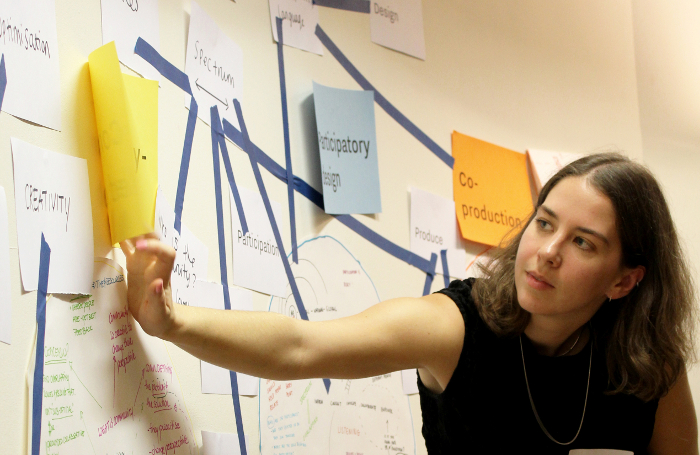Community engagement is an important part of an architect’s skill set. Projects that are community-led are becoming increasingly common, providing architects with opportunities for genuinely collaborative work. Such projects empower the most important stakeholders: the users of a building.
Experts in community engagement use techniques that architects can learn from to give real value to residents’ design input. The Glass-House Community Led Design is a London-based charity that facilitates community engagement in the built environment throughout the UK.
It has seen a genuine shift in the perceived value of providing residents with more ownership of the design process. Accordingly, it has developed a repertoire of engagement techniques, and it offers CPD to architects on how they can apply their methods.
“We remind architects of the importance of taking time at the beginning of a project to create an engagement strategy, including at what point you integrate community input into a project,” says Outreach Manager Grace Crannis.
The Glass-House has a variety of resources on its website that architects can draw upon to develop their engagement techniques.
Community-led design where integration happens at the outset and is sustained throughout the life of a project produces the best results, Crannis suggests. To achieve this, a non-hierarchical steering group might be set up with community representatives, the client, the architect and other stakeholders.
The level of participation and input a community has will vary from project to project. While architects are design professionals with a wealth of specialist technical knowledge, their role in a community project crosses over into that of an ‘enabler’.
One strategy that is invaluable is to provide residents with a way to speak about design. A workshop that essentially provides a crash course on design and its language to community representatives is an inclusive way of bringing them on board.
Avoiding any unnecessary jargon or ‘architect speak’, it is possible to show that complex concepts can be communicated in simple terms. Residents learn the basics of architectural design, scale-model making, and quickly appreciate the significance of maps and scales.
This kind of informal education helps them pass information on to other residents more effectively, and gives them the tools to speak with designers, contractors and planners, should they need to.
‘Field trips’ are another excellent device. Residents are taken to view a development of a similar scale and type, to assess the design approach used elsewhere. These can be energising experiences, in which residents can spot what might work in their context and, crucially, what would be inappropriate.
Considerations of public space are vital to social housing, and residents have a better understanding than anyone of what currently works well.

They are able to talk through the area they live on a map, providing feedback on their emotional responses to particular places.
Not enough architects consider emotion in the built environment, Crannis believes, so effective community engagement should be sensitive to how a cross-section of ages and backgrounds feel about specific areas.
“Residents can explain specifically that ‘this happens here’ and ‘that happens there’,” points out Myra Stuart, Design Enabling Research Manager at The Glass-House. “It is inspiring to see how quickly they start to take ownership of their spaces and processes.”
Crannis reminds architects not to underestimate the value of local knowledge that can be tapped into. Bringing together the architect’s skill set as an enabler with residents' insider knowledge in an effective way will deliver the strongest outcome, she argues.
Workshops with active participation are, of course, a mainstay of community engagement. The Glass-House has found that if residents and community organisers in attendance are given equal weight as design professionals and council members, then a different kind of conversation will emerge: one better informed by accurate needs and requirements.
At one level, architects can present multiple options to communities: explaining the repercussions and results of different courses of action in a regeneration project, for instance, such as redevelopment, demolition or infill if applicable. A series of workshops can be used to explore each option, so when a residents’ ballot takes place, it can be a properly informed decision.
Every project is different, so there are no cut-and-paste solutions. “Decisions should be taken based on gathered evidence rather than an outsider’s abstract assessment,” states Stuart. “An architect could design what they imagine is the perfect space, but if it ends up not being used, what is the point?”
Thanks to Grace Crannis, Outreach and Impact Manager, and Myra Stuart, Design Enabling Research Manager, The Glass-House Community Led Design.
RIBA Core Curriculum Topic: Architecture for social purpose.
As part of the flexible RIBA CPD programme, Professional Features count as microlearning. See further information on the updated RIBA CPD Core Curriculum and on fulfilling your CPD requirements as an RIBA Chartered Member.
The RIBA publishes a wealth of further guidance on working on community-led projects.
20/20 Visions by Charles Campion is an inspiring introduction to the practice of participatory planning, featuring 20 worldwide case studies. Rescue & Reuse by Merlin Waterson explores how historic buildings across the UK have been brought back to life through the creativity and sensitivity of architects working in partnership with local people.
Text by Neal Morris. This is a Professional Feature edited by the RIBA Practice team. Send us your feedback and ideas.









